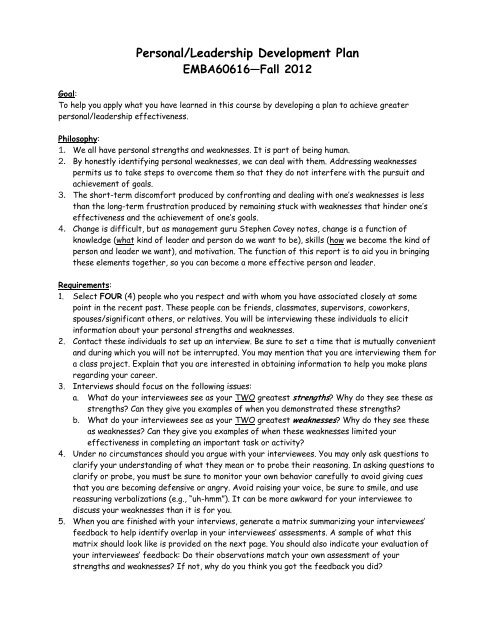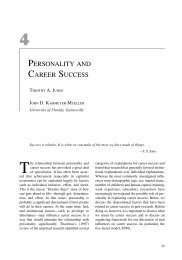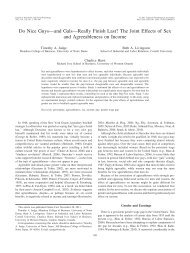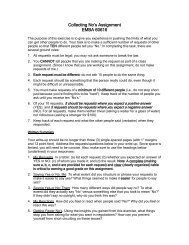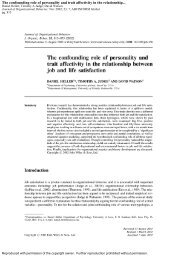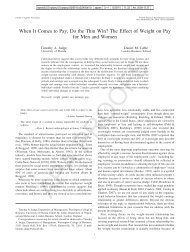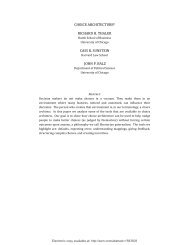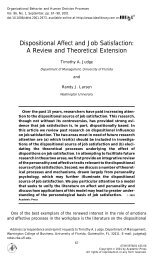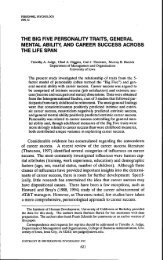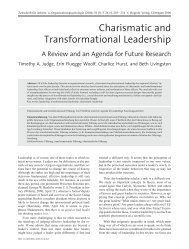Personal/Leadership Development Plan - Timothy A. Judge
Personal/Leadership Development Plan - Timothy A. Judge
Personal/Leadership Development Plan - Timothy A. Judge
Create successful ePaper yourself
Turn your PDF publications into a flip-book with our unique Google optimized e-Paper software.
<strong>Personal</strong>/<strong>Leadership</strong> <strong>Development</strong> <strong>Plan</strong>EMBA60616—Fall 2012Goal:To help you apply what you have learned in this course by developing a plan to achieve greaterpersonal/leadership effectiveness.Philosophy:1. We all have personal strengths and weaknesses. It is part of being human.2. By honestly identifying personal weaknesses, we can deal with them. Addressing weaknessespermits us to take steps to overcome them so that they do not interfere with the pursuit andachievement of goals.3. The short-term discomfort produced by confronting and dealing with one’s weaknesses is lessthan the long-term frustration produced by remaining stuck with weaknesses that hinder one’seffectiveness and the achievement of one’s goals.4. Change is difficult, but as management guru Stephen Covey notes, change is a function ofknowledge (what kind of leader and person do we want to be), skills (how we become the kind ofperson and leader we want), and motivation. The function of this report is to aid you in bringingthese elements together, so you can become a more effective person and leader.Requirements:1. Select FOUR (4) people who you respect and with whom you have associated closely at somepoint in the recent past. These people can be friends, classmates, supervisors, coworkers,spouses/significant others, or relatives. You will be interviewing these individuals to elicitinformation about your personal strengths and weaknesses.2. Contact these individuals to set up an interview. Be sure to set a time that is mutually convenientand during which you will not be interrupted. You may mention that you are interviewing them fora class project. Explain that you are interested in obtaining information to help you make plansregarding your career.3. Interviews should focus on the following issues:a. What do your interviewees see as your TWO greatest strengths? Why do they see these asstrengths? Can they give you examples of when you demonstrated these strengths?b. What do your interviewees see as your TWO greatest weaknesses? Why do they see theseas weaknesses? Can they give you examples of when these weaknesses limited youreffectiveness in completing an important task or activity?4. Under no circumstances should you argue with your interviewees. You may only ask questions toclarify your understanding of what they mean or to probe their reasoning. In asking questions toclarify or probe, you must be sure to monitor your own behavior carefully to avoid giving cuesthat you are becoming defensive or angry. Avoid raising your voice, be sure to smile, and usereassuring verbalizations (e.g., “uh-hmm”). It can be more awkward for your interviewee todiscuss your weaknesses than it is for you.5. When you are finished with your interviews, generate a matrix summarizing your interviewees’feedback to help identify overlap in your interviewees’ assessments. A sample of what thismatrix should look like is provided on the next page. You should also indicate your evaluation ofyour interviewees’ feedback: Do their observations match your own assessment of yourstrengths and weaknesses? If not, why do you think you got the feedback you did?
Sample Feedback Summary Matrix:AREASINTERVIEWEESIDENTIFIED Spouse Boss Coworker SubordinateStrengths Strong communicationskillsWrite & speakwell, very clearStrong writingskillsGood job keepingme informed Positive outlook on life Pleasant, friendly Nice/cooperative Optimistic, kind Superior analytic ability High quality work Superior workqualityWeaknesses Perfectionist Take on too much work Avoid conflict even whenneeded/too niceOverly critical ofselfLet others walk onyouToo much time ondetails that don’tadd valueShould delegatemore tosubordinatesLittle time left forselfShould be moredirect indisagreementsPicky, sometimestoo detailedSeem overworked& stressed6. Using this summary, select ONE weakness to improve. The weakness should be something onwhich you and your interviewees agree is likely to hinder you in pursuit of your career goals. Itshould also be something you can realistically work toward improving.7. Identify: (a) sources that can help you overcome or address the weakness; (b) situations inwhich you are likely to exhibit the weakness; (c) a plan for what you will do to overcome theweakness in those situations. For example, a weakness may be that your organizational skills arepoor—e.g., you do not spend enough time planning; when you do plan, the schedules you set areunrealistic; and you do not follow through with deadlines. In the future, you may be working onseveral class or work projects that will require stronger organizational skills. Therefore, you willmay decide that you will use these opportunities to practice your organizational skills. You maypurchase books on improving planning/organizational skills. You may attend a seminar designed toaid you in time management. You might purchase an organizer and plan to use it.8. The self-management plan, as part of the PDP, should include the following:a. How you will handle situations that arise—i.e., your goals. What specifically will you do thatwill provide a more effective method for handling the situation than what you have done inthe past? Goals should be specific and moderately challenging.b. What obstacles you are likely to encounter as you try to change how you handle thosesituations. What specific challenges do you face?c. How you will monitor your progress. Will you use a diary or plot your progress on a schedule?You MUST select a way to measure your performance over time. You must also decide howoften to evaluate your progress—this will vary with the choice of weaknesses addressed.d. What rewards you will give yourself for making progress? Rewards should be somethingmeaningful and personally relevant.9. You will track your progress over eight (8) weeks. Whatever monitoring method you chooseshould permit easy assessment on a regular basis.10. Your PDP is limited to 5 single-spaced pages, and is due in class on September 1.
Caveats:1. This project is designed to help you learn how to develop your skills and talents. To get the mostout of this project, you must take it seriously. Only by doing so will you learn from it.2. I do not wish to embarrass or intimidate any student through this project. PLEASE—include onlythe information you feel comfortable in sharing. You need not disclose specific comments ofyour interviewees or particular problems you experienced. I require only that you provide mewith a summary of issues raised by interviewees and the steps you took to confront andovercome one weakness. Grades will be based on the thoroughness of your analysis andapplication of course principles, not on how much you choose to disclose.3. Your PDPs are confidential. Only I will read your PDPs and all information contained in them willbe kept strictly confidential. So, while you should only share information you feel comfortablesharing, do not worry about your PDP being made public.4. The personal strengths and weaknesses you identify should be relevant to your career plans andgoals. On the other hand, if you or others believe a personal strength or weakness is relevant toyour career, it probably is relevant and should be included in the PDP. Just make the linkageclear in your plan (i.e., spell out how the personal strength or weakness bears on your careerplans or goals).PDP Required Components:1. Introductiona. What are your career goals?b. What skills are required to attain these goals? How do you know these skills are necessary?2. Summary of interviewee feedback in matrix form and discussiona. Which areas overlapped across interviewees? Which areas diverged? Provide specificexamples that were given by interviewees to illustrate areas.b. What feedback surprised you? What feedback came as no surprise?3. Analysis of how this information bears on your career goalsa. What areas do you need to develop to pursue your career goals successfully?b. Which weakness did you select to work on right now? Why did you choose this one?4. Summary of your self-management plana. What resources did you find on how to improve your skills in your one selected area? Wheredid you look for resources and information? What key points did you learn regardingimproving your skills?b. What situations will require you to exhibit skillful performance relevant to this weakness?c. What are your goals for improving your skill in this area—what performance level do youwant to reach? How will you know when you have reached this level?d. What obstacles do you anticipate? How do you plan to overcome those obstacles? Bespecific!e. How will you monitor or track your progress (e.g., diary, chart, schedule)? Why did youchoose this method? How is it adapted to your unique circumstances?f. How will you reward yourself for goal attainment? When will you self-administer thoserewards (i.e., at what milestones)?


